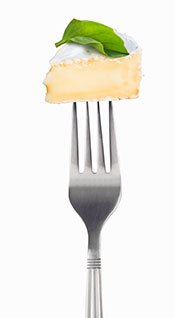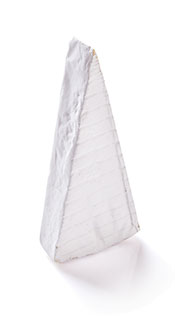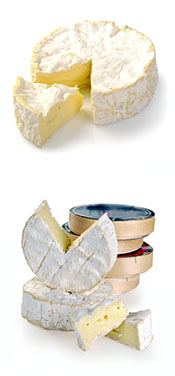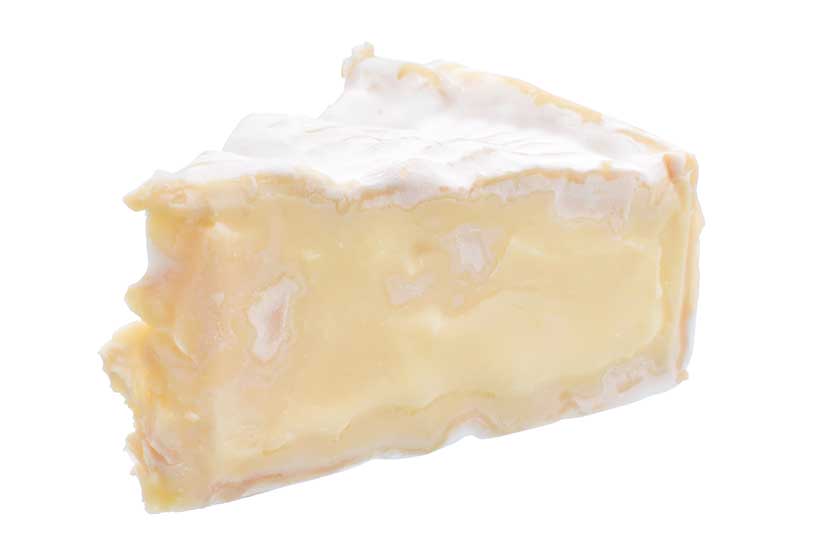
With a soft, creamy texture and a deep, flavorful taste, Camembert enjoys global appeal.
In this article, we examine the nutrition profile and health benefits of this tasty cheese.
Additionally, many people feel confused about the differences between Camembert and Brie.
How are they different?
Also, what are the best ways to use Camembert?
What Is Camembert Cheese?
Camembert is a traditional French cheese that dates back to the late 18th century.
With origins in the town of Camembert, Normandy, the cheese has a strong cultural relevance in its home nation.
In fact, much of the affection people have for it came from the cheese keeping French soldiers nourished during the first World War.
With a minimum milk fat percentage of 45%, Camembert has a buttery, creamy taste with a deep flavor.
This intense flavor can also split opinion; some people love Camembert, but others are put off by its pungent taste.
Since the cheese requires minimal time to ferment, it has a very soft texture.
While some types of aged hard cheese like Cheddar can require years of aging, the typical aging process for Camembert is only a minimum of three weeks.
Camembert is usually eaten raw and often plays a part in cheese platters. Also, some people enjoy to bake it.
Pasteurization
Traditionally, French producers make Camembert using raw, unpasteurized milk.
However, due to hygiene and regulatory concerns over raw milk, a significant number of Camembert cheesemakers now use pasteurized milk.
Notably, the United States is one of the countries that do not allow the sale of unpasteurized Camembert (1).
Nutrition Facts
The following tables show the nutrition profile per 100 grams of Camembert cheese (2).
Calories and Macronutrients
| Amount (kcal/grams) | |
| Calories | 300 kcal |
| Carbohydrate | 0.5 g |
| Fiber | 0 g |
| Sugar | 0.5 g |
| Fat | 24.3 g |
| Saturated Fat | 15.3 g |
| Monounsaturated Fat | 7.0 g |
| Polyunsaturated Fat | 0.7 g |
| Omega-3 | 274 mg |
| Omega-6 | 450 mg |
| Protein | 19.8 g |
As shown, Camembert is high in protein and fat – mainly saturated and monounsaturated fatty acids.
The cheese provides a minimal amount of carbohydrate, and only contains trace amounts of sugar (lactose).
Vitamins
In order of significance, here is Camembert’s vitamin profile;
| Vitamin | Amount (% RDA) |
| Riboflavin | 29% |
| Vitamin B12 | 22% |
| Vitamin A | 16% |
| Folate | 16% |
| Pantothenic Acid | 14% |
| Vitamin B6 | 11% |
| Vitamin D | 3% |
| Niacin | 3% |
Camembert provides a decent range of B vitamins, and it is a good source of vitamin A.
Additionally, the cheese provides trace amounts of vitamins E and K1.
Depending on the specific cheese and type of bacterial culture used, Camembert may also supply a good amount of vitamin K2.
Minerals
| Mineral | Amount (% RDA) |
| Calcium | 39% |
| Phosphorus | 35% |
| Sodium | 35% |
| Selenium | 31% |
| Zinc | 16% |
| Magnesium | 5% |
| Potassium | 5% |
| Iron | 2% |
| Manganese | 2% |
| Copper | 1% |
Similar to other dairy products, Camembert is a significant source of calcium and phosphorus, and it contains a wide range of essential minerals.
Health Benefits of Camembert Cheese
Camembert has a range of benefits and potential benefits.
1. May Benefit Heart Health
Despite the historical fear of foods high in fat, we have realized that there are good and bad fats.
Firstly, several research studies have looked into the connection between dairy foods and cardiovascular health in recent years.
Markedly, several systematic reviews demonstrate that fermented dairy products like Camembert may decrease our risk of vascular diseases and cardiovascular events.
These studies consistently find either a neutral or favorable impact on the risk of cardiovascular disease and stroke (3, 4, 5, 6).
Additionally, randomized trials on human participants show that regular intake of cheese raises HDL cholesterol and either lowers or has no effect on LDL cholesterol.
As a result, cheese consumption appears to improve the overall lipid profile (7, 8, 9).
2. Substantial Source of Calcium
Camembert provides a large concentration of calcium, and a 50-gram portion supplies 20% of the mineral’s recommended daily allowance.
Adequate calcium intake is vital for our bone health and, alongside support nutrients, a sufficient intake may reduce the risk of osteoporosis (10, 11).
Dairy sources of calcium are also far more bioavailable than (most) vegetable sources of the mineral.
For instance, calcium from cheese has an absorption rate of approximately 30 – 35% (12).
In contrast, the plant foods highest in calcium, such as spinach and rhubarb, have an absorption rate of less than 10%.
3. Contains a Wide Range of Beneficial Bacteria
The rind (“mold”) of Camembert contains a substantial concentration of micro-organisms that we commonly call “beneficial bacteria.”
Further to that, this bacteria enters our digestive system where some may reside and contribute to a healthy intestinal microbiota.
Studies show that Camembert consumption will not significantly change the composition of the gut microbiota.
However, they also show that some bacteria survive digestion and become part of the gut bacterial colony (13).
Additionally, the population of a bacteria known as Enterococcus faecium is “significantly enhanced” by Camembert intake (14).
Having a healthy gut microbiota is believed to benefit our overall health, and may play a role in reducing the risk for obesity and type 2 diabetes (15, 16).
4. Rich In Protein
With a 20% protein density, Camembert is an excellent source of protein, and almost provides as much as the amount in meat.
Protein has a variety of benefits for our health, and it is essential for the growth and repair of our body and plays a role in immune response (17).
Furthermore, protein is the most satiating out of the three macronutrients; sufficient intake provides a greater feeling of fullness and decreases appetite (18, 19).
Higher protein intake is also associated with more lean mass, particularly when combined with resistance training, which has benefits for our overall health (20).
How Is Camembert Made?
Although it is not as quick as fresh options like cottage cheese, Camembert has a very short aging process and takes only several weeks before it is ready.
The process of making Camembert involves several stages (21);
- Heating: First of all, milk is heated and then mixed with various bacterial starter cultures as well as ripening cultures.
- Coagulation: Once the cheesemakers add the starter cultures, the next stage is to coagulate the milk using rennet. Rennet contains enzymes that curdle the casein protein within milk. After adding the rennet, cheesemakers allow the curd to set and become firm.
- Preparing the curds: After the curd has become firm, it is cut into small cubes which are then salted and placed in Camembert molds.
- Draining: Over the following two days, the cheesemaker drains the curds of excess liquid and whey by regularly turning them. After this state, the cheese develops a hard and crumbly texture.
- Adding mold: Once the cheese has the desired texture, it is sprayed with a mold known as Penicillium camemberti. Following this, the cheese is given a legal minimum of three weeks for ripening.
- Finished product: During the ripening stage, the Camembert develops a white surface mold and a soft, creamy inner texture. Once this is complete, the Camembert is ready for packaging and shipping.
If you are curious about Camembert’s production process, you can see a video of it here.
Camembert vs. Brie: What is the Difference?
Many people feel confused over the difference between Camembert and another famous French cheese called Brie.
For one thing, both these varieties of cheese share several commonalities;
- They often look very similar and can look exactly the same in some cases.
- Both are soft-ripened cheese with a soft and creamy texture.
- Brie and Camembert are both traditional forms of French cheese.
However, there are some apparent differences between the two types of cheese, as documented below;
| Brie | Camembert | |
| Origin: | Ile-de-France | Normandy |
| Fat Content: | 60% + | 45% + |
| Made With: | Milk + added cream | Milk |
| Texture: | Light, creamy, buttery | Light, creamy, buttery |
| Taste Profile: | Mild, fruity, buttery | Strong, fruity, earthy |
Production Process
During the production process, cheesemakers add cream to Brie, which gives it a higher milk fat content and a creamier feel than Camembert.
Additionally, Camembert uses stronger (and more) starter cultures than Brie, which is responsible for the stronger, deeper taste.
Taste Profile
To sum up, Brie has a milder taste, and Camembert has a stronger flavor.
While the differences depend on the specific cheese, Camembert can sometimes have a bitter taste, even tasting kind of “chalky.”
On other occasions, it may be milder and closer in taste to Brie.
The intense flavor is not necessarily a bad thing, and Camembert has a “deeper” cheese flavor than Brie.
Overall, it is a personal preference, and similar to how some people enjoy rich coffee and others prefer a mild brew.
Personally, I prefer Camembert due to its stronger cheese flavor and aroma.
How To Eat Camembert
With a moldy outer rind, many people new to Camembert feel unsure about how to eat it.
Here are some answers to common questions;
Can You Eat Camembert Without Cooking It?
Yes, Camembert can be eaten raw and it tastes great.
However, it is better to eat the cheese at room temperature as this makes the texture slightly soft and “gooey,” which is how the cheese is supposed to be eaten.
Eating the cheese directly after chilling gives it a harder, firm texture.
Can You Eat the Skin (Rind)?
It is safe to eat the whole cheese – rind included.
Providing the cheese has been stored well and has not developed any black mold, the natural white mold is not at all harmful.
Camembert’s rind also contains significant concentrations of “good” bacteria, so it may even have some health benefits.
How Long Should You Bake Camembert For?
If you decide to cook Camembert, then it only needs minimal time in the oven.
Baking the cheese at 180°C (355°F) for about 15 minutes is usually enough time.
Otherwise, bake until the center of the cheese becomes fully melted with slightly firm edges.
Recipe Ideas
There are all sorts of different ways to eat Camembert, but here are some of the more popular ideas.
1. Baked Camembert
Gently brush the outside of the cheese with extra virgin olive oil, and rub a sprinkling of sea salt into the skin.
After this, put the Camembert in a small oven dish and bake for 15 minutes at a temperature of 180°C (355°F).
Once ready, serve the cheese on a plate with some salad.
2. Cheese Platter
Cheese is always delicious, but it tastes even better when combined with cured meat and fruit.
Incorporating Camembert alongside some different cheese, meat, and fresh fruit also makes a great “finger food” for a social gathering.
3. Cheese, Wine and Berries
For those who enjoy the occasional drink of wine, Camembert makes a great combination with both red and white wines.
Since white wine has a lighter taste, it may be better for those who find the flavor of Camembert overly strong.
Final Thoughts
Camembert is a divisive cheese, and not everyone will be a fan due to its strong taste.
However, for those who enjoy stronger varieties of cheese, Camembert is a delicious option and one that is quite healthy too.
For a guide to another bold and flavorful cheese, see this review of blue Stilton.




